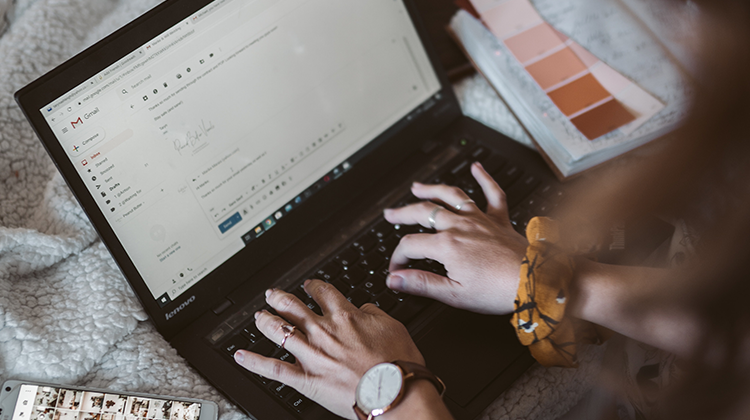Have you ever found yourself writing an email in Italian and had no idea where to start from? I know emails are fundamental in the workplace, and you must know very well how to write them, otherwise, your risk is to be misunderstood, or, in the worst case, to not be taken into consideration at all!
So, let’s first have a look at each part that compose a letter, and let’s see what words you can use to make each paragraph clear and concise.
You will start your email with a Greeting, which is basically an Opening formula. For formal letters, if you want to refer to a person with whom you do not have a close relationship, you may use adjectives like:
- Gentile
- Egregio
- Spettabile
Pay attention here, because if gentile is perfect almost for any formal email, you will use Egregio only when your interlocutor performs a duty of major responsibility like the president or the head of a company. While Spettabile is mostly used to refer to companies as a general greeting especially when you do not know the name of the person you would like to read your email. Notwithstanding this, you can also use it to refer to a single person and in this case, it assumes the same meaning as Egregio.
Instead, if you do not know the title of your recipient, you can call them
- Signore (for men)
- Signora (for women)
by using the following abbreviations Sig. or Sig.ra.
If, instead, you have knowledge of their title you can call them:
- Professore
- Professoressa
Both mean professor, and you can abbreviate them respectively to Prof. or Prof.ssa;
- Dottore
- Dottoressa
Both mean Ph.D., and you can abbreviate them respectively to Dott. or Dott.ssa.
You can also want to address your email to a specific company department if you do not know the name of the person you want to read your message. In this case, you can simply write • Alla cortese attenzione di + name of the department.
e.g. Alla cortese attenzione dell’Ufficio del personale.
Furthermore, if you want to sound more general, you can also write:
- Buongiorno/buon pomeriggio/buonasera
- Salve
I know, these are greetings that you can easily listen in your daily life and that are mainly used while speaking. Nonetheless, they are becoming more popular also in emails and are perfect to be used if you do not know the gender nor name of the recipient.
I am sure you know, that is a good habit to thank the other person if you have already received an email from them, so you can start your text with:
- La ringrazio per la Sua email/risposta.
Yes, the pronoun La, as well as the possessive adjective Sua, can be found written with the first capital letter. It is a form of politeness.
I know it sounds weird, it is like an old-fashioned way of writing letters or emails in the past, and I find it really elegant, yet I recognize that it almost fell into disuse nowadays.
On the other hand, if you want to apologize for any reason you can write:
- Mi scuso per...
- Sono spiacente di informarLa/comunicarLe...
- Mi dispiace comunicarLe...
Important is that if the email you are writing is the very first contact with the recipient, I recommend introducing yourself a bit.
You could start with:
- Mi presento, sono... or simply sono...
- Mi chiamo... and then add your name or degree.
e.g. Sono Anna Conti, Marketing Manager di ...
We now move to the Text Body, which is the main part of your message. It should be brief, clear and suited for your audience. In the text body, you explain the reason why you are writing your email.
- Con la presente sono a comunicarLe/informarLa
- Le comunico che... /La informo che...
- La contatto per...
- Le scrivo per comunicarLe/informarLa... / Le scrivo in merito a
Important, if you have also documents or files to be attached, you can inform the recipient by writing in allegato (attached) or Invio in allegato... (I hereby attach...)
And then, there is the Closing
Remember to thank your recipient. If you just want to thank them for their attention, you can use this formula:
- La ringrazio per l’attenzione
or simply:
- La ringrazio
And then add the final greeting:
- Distinti Saluti
- Cordiali Saluti
- Saluti
- Cordialmente
If your intent is to communicate that you are expecting a prompt reply you can add:
- In attesa di un (Suo) gentile riscontro
- RImango in attesa di Sue
And then add:
- La saluto cordialmente
Do not forget to add the comma and start a new line with your name and last name or simply your signature which usually also includes the logo of your company brand.
Finally, you will add a Subject Line that is like the title of your email so that your audience will know what to expect from your message.
It is a good habit to write the subject line after you have finished your email, thus you can have a general overview of your text that will help you summarize the content and be brief. Remember that being concise in your subject line will give you more chances to be taken into account by your recipient.
Now that we have studied some theory, let’s see an example of a formal email!
Formal:
Gentile Professoressa Della Valle,
sono Laura Riva, laureanda al corso di laurea magistrale in “Economia e management”. La contatto per confermarle la mia presenza al ricevimento di Lunedì 18 alle ore 12:00 nel suo ufficio e Le invio in allegato la bozza del primo capitolo di tesi.
La ringrazio per l’attenzione e la saluto cordialmente,
Laura Riva
Good! That is all for today’s lesson.
Thank you for reading this article!
If you want to learn more about me, feel free to check out my profile!
Ciao!







